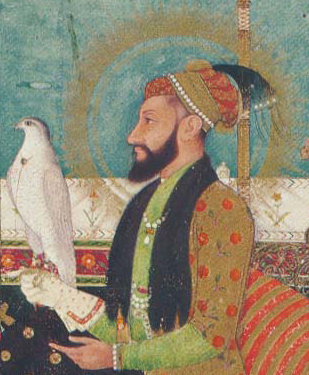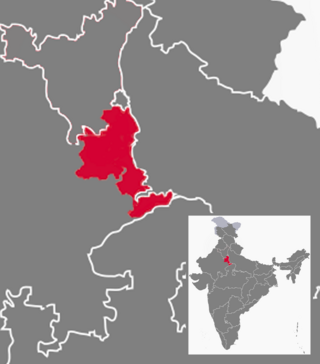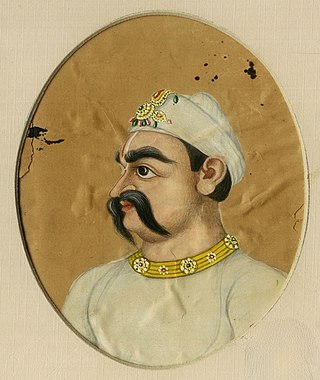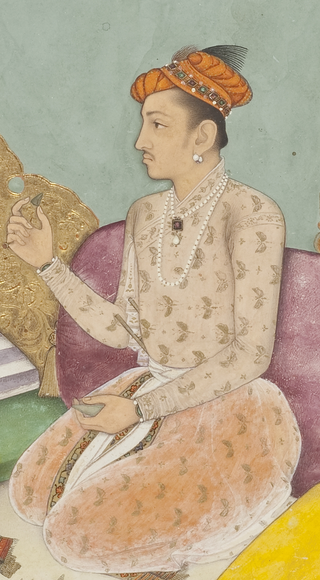Related Research Articles

Muhi al-Din Muhammad, commonly known as Aurangzeb, was the sixth Mughal emperor, reigning from 1658 until his death in 1707. His regnal name is Alamgir I, which derived from his title, Abu al-Muzaffar Muhi-ad-Din Muhammad Bahadur Alamgir Aurangzeb Badshah al-Ghazi. Under his emperorship, Mughal Empire reached its greatest extent with territory spanning nearly the entirety of the Indian subcontinent.

Maharaja Suraj Mal was a Jat ruler of Bharatpur in present-day state of Rajasthan. He is Known for his military prowess and administrative acumen, he established a prosperous kingdom in the region now encompassing parts of Rajasthan, Uttar Pradesh, and Haryana. Under him, the Jat rule covered the present-day districts of Agra, Alwar, Aligarh, Bharatpur, Dholpur, Etawa, Hathras, Mainpuri, Meerut, Ghaziabad, Mathura, and Rohtak, Sonipat, Jhajjar, Nuh, Palwal, Faridabad, Kasganj, Mainpuri, Firozabad, Bulandshahr.

Shah Alam II, also known by his birth name Ali Gohar, or Ali Gauhar, was the seventeenth Mughal emperor and the son of Alamgir II. Shah Alam II became the emperor of a crumbling Mughal Empire. His power was so depleted during his reign that it led to a saying in the Persian language, Sultanat-e-Shah Alam, Az Dilli ta Palam, meaning, 'The empire of Shah Alam is from Delhi to Palam', Palam being a suburb of Delhi.

Mewat is a historical and cultural region which encompasses parts of the modern-day states of Haryana, Rajasthan, and Uttar Pradesh in northwestern India.

Hathras is a historical city in Uttar Pradesh, India. It is the headquarters of Hathras district, formed on 3 May 1997 by merging parts of Aligarh, Mathura and Agra. It is part of the Aligarh Division.
Raja Ram was the first Jat leader, who organised a rebellion against Aurangzeb. He was the chieftain of Sinsini. Before Rajaram the Jats were organised by different village heads dotted around Agra, Mathura and the Yamuna river. To avenge the death of Gokula, Rajaram destroyed Akbar's tomb and dragged Akbar's bones and burned them with the help of the Jat Zamindars of Braj. After his death, his brother Churaman and son Fateh Singh continued the struggle against Aurangzeb.

Churaman was a Jat chieftain of Sinsini, Rajasthan. He became leader of the Jats after Rajaram's death. Bahadur Shah I made him a mansabdar after he supported him against Muhammad Azam Shah in becoming the emperor. He was also made the faujdar of Mathura, and the imperial highway from Delhi to Agra was placed under his protection by the Mughal Emperor.
Beswan is a town and a nagar panchayat in Aligarh district in the state of Uttar Pradesh, India. Beswan was a jagir which was ruled by Thenua Jat clan. Beswan was under The Hathras Kingdom part of Jat Kingdom in Uttar Pradesh.
Khair is a town and a municipal board in Aligarh district in the Indian state of Uttar Pradesh. Khair is the biggest town of Aligarh district. It is situated around 27 km from Aligarh, 114 km from Delhi and 60 km from Mathura.
Mahaban is a town and a nagar panchayat in Mathura district in the Indian state of Uttar Pradesh.

The Kingdom of Amber, also known as Kingdom of Dhundhar, and Jaipur State, was located in the north-eastern historic Dhundhar region of Rajputana and was ruled by the Kachwaha Rajput clan. It was established by Dulha Rai, possibly the last ruler of the Kachchhapaghata dynasty of Gwalior who migrated to Dausa and started his kingdom there with the support of Chahamanas of Shakambhari in the 12th century. Mostly through 12th to 15th century, the kingdom faced stagnation, sources were scarce. Under its ruler, Raja Chandrasen of Amber became a Sisodia vassal and fought in the Battle of Khanwa under Raja Prithviraj Kachhwaha.

Mirza Raja Jai Singh I was the senior most general and a high ranking mansabdar at the imperial court of Mughal Empire as well as the Kachwaha ruler of the Kingdom of Amber. His predecessor was his grand uncle, Mirza Raja Bhau Singh, the younger son of Mirza Raja Man Singh I.

Haryana, formed on 1 November 1966, is a state in North India. For the administrative purpose, Haryana is divided into 6 revenue divisions which are further divided into 22 districts. For Law and Order maintenance, it is divided into 5 Police Ranges and 4 Police Commissionerates.

The Hathras Fort, was constructed by Jat king Raja Dayaram Singh in the 18th century. It is located in the city of Hathras in Uttar Pradesh. Commonly known as Kila Gate, Hathras Fort is a popular tourist site, although it is not registered as a tourist place in Uttar Pradesh.

Nurpur kingdom in the Himalayan foothills of India was founded in 1064 A.D at north-eastern Bari Doab between the Ravi and the Beas rivers at the fusion of Kangra, Duggar, Majha, Dharab and Chamba areas which ended in 1815. The remnants of Nurpur kingdom exist as ruined forts, restored temples, water bodies, and canals in Nurpur tehsil, Fatehpur tehsil, Pathankot tehsil, Dhar Kalan tehsil, Jawali tehsil, Indora tehsil Bhattiyat tehsil, and Sihunta tehsil.

The Subah of Lahore was a province of the Mughal Empire encompassing the central Punjab and eastern Punjab, now divided between Pakistan and India. It was created as one of the original 12 Subahs of the Mughal Empire under the administrative reforms carried by Akbar in 1580. The province ceased to exist after the death of its last viceroy, Adina Beg in 1758, with large parts being incorporated into Durrani Empire. Collectively, Lahore and Multan Subahs comprised Mughal Punjab.

Ballabhgarh estate, historically known as Ballabgarh estate was a jagir or estate in Haryana, India, ruled by Jats of Tewatia clan. It was founded by Jat king Raja Gopal Tewatia on 1705.

Fatehpur State, or the Principality of Fatehpur, was a Jat state ruled by Sogarwar or Sogharia Jats from 1684 to 1726 AD.
References
- 1 2 Sharma, Brij Kishore (2008). Social, Economic and Political Contribution of Caste Associations in Northern India: A Case Study of All India Jat Mahasabha. Har-Anand Publications. ISBN 978-81-241-1412-4.
- ↑ Jafar, Mahmud Syed; Mahmud, Sayed Jafar (1994). Pillars of Modern India, 1757-1947. APH Publishing. ISBN 978-81-7024-586-5.